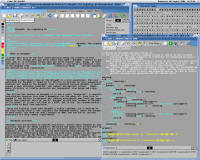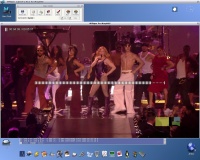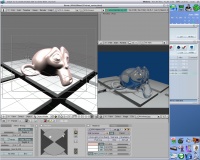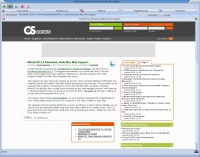Difference between revisions of "Compatibilité entre Plate-forme"
From MorphOS Library
Thebucheron (talk | contribs) |
Thebucheron (talk | contribs) |
||
| Line 9: | Line 9: | ||
[[File:MPlayer.jpg|200px|thumb|left|An old version of MPlayer on MorphOS]][[File:Blender.jpg|200px|thumb|left|The 3D modeling and rendering program Blender]]Quand AmigaOS a été conçu, un certain nombre de structures et de caractéristiques ont été inspirées par Unix, et naturellement on les retrouvent dans "l'ABox", l'API de MorphOS. Ainsi la conversion de commandes shell, utilitaires, programmes, et jeux d'Unix à AmigaOS, et maintenant de Linux à MorphOS, n'est parfois pas difficile. Deux bibliothèques système spécifiques ("ixemul.library" et "ixnet.library") permettent de faciliter la conversion de programmes exigeant des routines spéciales Linux. Même de grandes et complexes applications comme "MPlayer", "MEncoder", "MLDonkey", "E-UAE", "MAME", "Blender", ont été portées sur MorphOS. | [[File:MPlayer.jpg|200px|thumb|left|An old version of MPlayer on MorphOS]][[File:Blender.jpg|200px|thumb|left|The 3D modeling and rendering program Blender]]Quand AmigaOS a été conçu, un certain nombre de structures et de caractéristiques ont été inspirées par Unix, et naturellement on les retrouvent dans "l'ABox", l'API de MorphOS. Ainsi la conversion de commandes shell, utilitaires, programmes, et jeux d'Unix à AmigaOS, et maintenant de Linux à MorphOS, n'est parfois pas difficile. Deux bibliothèques système spécifiques ("ixemul.library" et "ixnet.library") permettent de faciliter la conversion de programmes exigeant des routines spéciales Linux. Même de grandes et complexes applications comme "MPlayer", "MEncoder", "MLDonkey", "E-UAE", "MAME", "Blender", ont été portées sur MorphOS. | ||
| − | + | Les principaux obstacles pour convertir le code sont l'absence de la fonction "fork()" dans AmigaOS et "l'ABox" de MorphOS, le fait qu'AmigaOS/MorphOS ne sont pas entièrement conforme à la norme POSIX, et l'extrême difficulté de la conversion de la GUI. Les GUIs Linux sont basés sur des systèmes de fenêtrage qui sont habituellement des parties de grands environnements de bureau, et ne sont pas intégrés dans l'OS. Mis à part un port rapide et embryonnaire très récent de "X-Windows", aucun système de fenêtrage Linux n'a jamais été porté sur AmigaOS/MorphOS. Un tel port n'offrirait d'ailleurs aucun réel avantage... Tout d'abord parce que le port serait très difficile à faire et ensuite parce que le plus petit système de fenêtrage Linux est au moins 5 fois plus grand que MorphOS lui-même. La simple conversion d'une GUI exigerait la perte complète du caractère compact de MorphOS, et le transformerait en nouveau et inutile OS de style Linux. | |
So, contrary to other platforms, AmigaOS/MorphOS never had a port of very large and important applications like Mozilla and Open Office. The absence of programs like these, that are fundamental for a normal user who wants to interface his computer with the whole cyberworld without compatibility problems, is the biggest obstacle for a larger adoption of MorphOS in the desktop computer market. | So, contrary to other platforms, AmigaOS/MorphOS never had a port of very large and important applications like Mozilla and Open Office. The absence of programs like these, that are fundamental for a normal user who wants to interface his computer with the whole cyberworld without compatibility problems, is the biggest obstacle for a larger adoption of MorphOS in the desktop computer market. | ||
[[File:OWB.jpg|200px|thumb|right|Origyn Web Browser]]Once people recognised the uselessness of porting large pieces of Linux distributions to MorphOS, a better idea emerged: the creation of wrappers that relate all the calls to certain basic structures of one system to their equivalents in the other system. As mentioned above, one attempt in this direction concerns GTK (the GIMP Toolkit, where GIMP is the acronym of GNU Image Manipulation Program), and tries to relate this popular widget toolkit for creating GUIs for the ''X-Windows'' system to the corresponding widgets of ''MUI''. Anyway, the most relevant current port is the MorphOS version of the ''Origyn Web Browser'' (OWB), which is - like Apple's Safari - based on the WebKit engine and thus provides MorphOS users with a state-of-the-art browser. Again the MorphOS version is not just a quick recompile but diligently integrated into the overall look & feel of the operating system (including ''ARexx'' support), providing all the common user's needs like cookie and password management, support for different languages and mime types, content blocking, configurable context menus e.g. displaying recently closed tabs and visited sites, session saving/restoration and also a Flash-plugin based on the MorphOS port of ''swfdec''. | [[File:OWB.jpg|200px|thumb|right|Origyn Web Browser]]Once people recognised the uselessness of porting large pieces of Linux distributions to MorphOS, a better idea emerged: the creation of wrappers that relate all the calls to certain basic structures of one system to their equivalents in the other system. As mentioned above, one attempt in this direction concerns GTK (the GIMP Toolkit, where GIMP is the acronym of GNU Image Manipulation Program), and tries to relate this popular widget toolkit for creating GUIs for the ''X-Windows'' system to the corresponding widgets of ''MUI''. Anyway, the most relevant current port is the MorphOS version of the ''Origyn Web Browser'' (OWB), which is - like Apple's Safari - based on the WebKit engine and thus provides MorphOS users with a state-of-the-art browser. Again the MorphOS version is not just a quick recompile but diligently integrated into the overall look & feel of the operating system (including ''ARexx'' support), providing all the common user's needs like cookie and password management, support for different languages and mime types, content blocking, configurable context menus e.g. displaying recently closed tabs and visited sites, session saving/restoration and also a Flash-plugin based on the MorphOS port of ''swfdec''. | ||
Revision as of 10:35, 20 May 2016
Quoi qu'il en soit, quand une plateforme informatique a une petite base d'utilisateurs comme MorphOS, le développement de nouveaux logiciels devient difficile. La production de logiciel commercial n'est pas encouragée, puisqu'il n'y a qu'une petite probabilité de trouver un nombre suffisamment grand d'acheteurs. La production de logiciel Open Source et de shareware est constante, ou augmente très lentement, parce qu'elle ne trouve pas une base suffisamment grande de codeurs : chacun étant déjà concentré sur un certain nombre de projets ne leur laissant pas de temps pour d'autres. Dans ces conditions, il existe une solution qui parfois peut réduire considérablement le temps d'élaboration d'une application : la conversion d'un logiciel issu d'une autre plateforme.
Les principaux obstacles pour convertir le code sont l'absence de la fonction "fork()" dans AmigaOS et "l'ABox" de MorphOS, le fait qu'AmigaOS/MorphOS ne sont pas entièrement conforme à la norme POSIX, et l'extrême difficulté de la conversion de la GUI. Les GUIs Linux sont basés sur des systèmes de fenêtrage qui sont habituellement des parties de grands environnements de bureau, et ne sont pas intégrés dans l'OS. Mis à part un port rapide et embryonnaire très récent de "X-Windows", aucun système de fenêtrage Linux n'a jamais été porté sur AmigaOS/MorphOS. Un tel port n'offrirait d'ailleurs aucun réel avantage... Tout d'abord parce que le port serait très difficile à faire et ensuite parce que le plus petit système de fenêtrage Linux est au moins 5 fois plus grand que MorphOS lui-même. La simple conversion d'une GUI exigerait la perte complète du caractère compact de MorphOS, et le transformerait en nouveau et inutile OS de style Linux.
So, contrary to other platforms, AmigaOS/MorphOS never had a port of very large and important applications like Mozilla and Open Office. The absence of programs like these, that are fundamental for a normal user who wants to interface his computer with the whole cyberworld without compatibility problems, is the biggest obstacle for a larger adoption of MorphOS in the desktop computer market.
Once people recognised the uselessness of porting large pieces of Linux distributions to MorphOS, a better idea emerged: the creation of wrappers that relate all the calls to certain basic structures of one system to their equivalents in the other system. As mentioned above, one attempt in this direction concerns GTK (the GIMP Toolkit, where GIMP is the acronym of GNU Image Manipulation Program), and tries to relate this popular widget toolkit for creating GUIs for the X-Windows system to the corresponding widgets of MUI. Anyway, the most relevant current port is the MorphOS version of the Origyn Web Browser (OWB), which is - like Apple's Safari - based on the WebKit engine and thus provides MorphOS users with a state-of-the-art browser. Again the MorphOS version is not just a quick recompile but diligently integrated into the overall look & feel of the operating system (including ARexx support), providing all the common user's needs like cookie and password management, support for different languages and mime types, content blocking, configurable context menus e.g. displaying recently closed tabs and visited sites, session saving/restoration and also a Flash-plugin based on the MorphOS port of swfdec.


